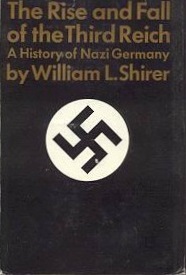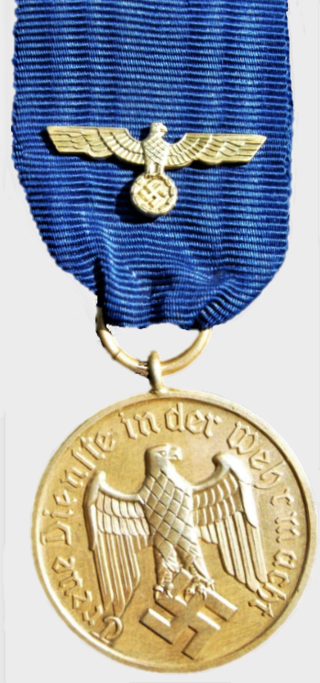
The swastika is an ancient religious and cultural symbol, predominantly found in various Eurasian cultures, as well as some African and American ones. In the western world it is more widely recognized as a symbol of the German Nazi Party who appropriated it from Asian cultures starting in the early 20th century. The appropriation continues with its use by neo-Nazis around the world. The swastika never stopped being used as a symbol of divinity and spirituality in Indian religions, including Hinduism, Buddhism, and Jainism. It generally takes the form of a cross, the arms of which are of equal length and perpendicular to the adjacent arms, each bent midway at a right angle.

The American Nazi Party (ANP) is an American far-right and neo-Nazi political party founded by George Lincoln Rockwell and headquartered in Arlington, Virginia. The organization was originally named the World Union of Free Enterprise National Socialists (WUFENS), a name to denote opposition to state ownership of property, the same year—it was renamed the American Nazi Party in order to attract 'maximum media attention'. Since the late 1960s, a number of small groups have used the name "American Nazi Party" with most being independent of each other and disbanding before the 21st century. The party is based largely upon the ideals and policies of Adolf Hitler's Nazi Party in Germany during the Nazi era, and embraced its uniforms and iconography.

The Rise and Fall of the Third Reich: A History of Nazi Germany is a book by American journalist William L. Shirer in which the author chronicles the rise and fall of Nazi Germany from the birth of Adolf Hitler in 1889 to the end of World War II in Europe in 1945. It was first published in 1960 by Simon & Schuster in the United States. It was a bestseller in both the United States and Europe, and a critical success outside Germany; in Germany, criticism of the book stimulated sales. The book was feted by journalists, as reflected by its receipt of the National Book Award for non-fiction, but the reception from academic historians was mixed.
Awards and decorations of Nazi Germany were military, political, and civilian decorations that were bestowed between 1923 and 1945, first by the Nazi Party and later the state of Nazi Germany.

The association of Nazism with occultism occurs in a wide range of theories, speculation, and research into the origins of Nazism and into Nazism's possible relationship with various occult traditions.

The flag of Nazi Germany, officially the flag of the German Reich, featured a red background with a black swastika on a white disc. This flag came into use initially as the banner of the Nazi Party (NSDAP) after its foundation. Following the appointment of Adolf Hitler as Chancellor in 1933, this flag was adopted as mandatory for use, while the national one was the black-white-red triband of the German Empire.
Fascist symbolism is the use of certain images and symbols which are designed to represent aspects of fascism. These include national symbols of historical importance, goals, and political policies. The best-known are the fasces, which was the original symbol of fascism, and the swastika of Nazism.

The 20th-century German Nazi Party made extensive use of graphic symbols, especially the swastika, notably in the form of the swastika flag, which became the co-national flag of Nazi Germany in 1933, and the sole national flag in 1935. A very similar flag had represented the Party beginning in 1920.

The Nazi Party/Foreign Organization was a branch of the Nazi Party and the 43rd and only non-territorial Gau ("region") of the Party. In German, the organization is referred to as NSDAP/AO, "AO" being the abbreviation of the German compound word Auslands-Organisation. Although Auslands-Organisation would be correctly written as one word, the Nazis chose an obsolete spelling with a hyphen.

Nazi memorabilia are items produced during the height of Nazism in Germany, particularly the years between 1933 and 1945. Nazi memorabilia includes a variety of objects from the material culture of Nazi Germany, especially those featuring swastikas and other Nazi symbolism and imagery or connected to Nazi propaganda. Examples are military and paramilitary uniforms, insignia, coins and banknotes, medals, flags, daggers, guns, posters, contemporary photos, books, publications, and ephemera.

The Pink Swastika: Homosexuality in the Nazi Party is a 1995 pseudohistorical book by Scott Lively and Kevin Abrams. Drawing on Samuel Igra's 1945 book Germany's National Vice, Lively and Abrams argue that the crimes committed by homosexuals in the Nazi Party exceed the persecution of homosexuals in Nazi Germany and that homosexuality contributed to the extreme militarism of Nazi Germany. They contend that only feminine homosexuals were persecuted by the Nazis, while "butch" homosexuals formed the leadership cadre of the Nazi party. Historian Andrew Wackerfuss criticized the book for lack of accuracy and "outright homophobic charges". The claim advanced by Igra, Lively, and Abrams that homosexuals were responsible for Nazi atrocities is rejected by most historians.
National Socialist Party of America v. Village of Skokie, 432 U.S. 43 (1977), arising out of what is sometimes referred to as the Skokie Affair, was a landmark decision of the US Supreme Court dealing with freedom of speech and freedom of assembly. This case is considered a "classic" free speech case in constitutional law classes. Related court decisions are captioned Skokie v. NSPA, Collin v. Smith, and Smith v. Collin. The Supreme Court ruled 5–4, per curiam. The Supreme Court's 1977 ruling granted certiorari and reversed and remanded the Illinois Supreme Court's denial to lift the lower court's injunction on the NSPA's march. In other words: the courts decided a person's assertion that speech is being restrained must be reviewed immediately by the judiciary. By requiring the state court to consider the neo-Nazis' appeal without delay, the U.S. Supreme Court decision opened the door to allowing the National Socialist Party of America to march.

The Ministry of Aviation was a government department during the period of Nazi Germany (1933–45). It is also the original name of the Detlev-Rohwedder-Haus building on the Wilhelmstrasse in central Berlin, Germany, which today houses the German Finance Ministry.

The swastika is an ancient Eurasian religious symbol that generally takes the form of an equilateral cross with four legs each bent at 90 degrees in either right-facing (卐) form or left-facing (卍) form. It is considered to be a sacred and auspicious symbol in Hinduism, Buddhism, and Jainism and dates back at least 11,000 years.
The German Strafgesetzbuch in section § 86a outlaws "use of symbols of unconstitutional and terrorist organizations" outside the contexts of "art or science, research or teaching". The law does not name the individual symbols to be outlawed, and there is no official exhaustive list. However, the law has primarily been used to outlaw fascist, Nazi, communist, Islamic extremist and Russian militarist symbols. The law, adopted during the Cold War, most notably affected the Communist Party of Germany, which was banned as unconstitutional in 1956; the Socialist Reich Party, which was banned in 1952; and several small far-right parties.
Fascist movements gained popularity in many countries in Asia during the 1920s.
The use of symbols of the Nazi Party and Nazi Germany (1933–1945) is currently subject to legal restrictions in a number of countries, such as Austria, Brazil, UK, Czech Republic, France, Germany, Hungary, Israel, Poland, Russia, Ukraine and other countries.

The Wehrmacht Long Service Award was a military service decoration of Nazi Germany issued for satisfactory completion of a number of years in military service.
Swastika is a 1973 British documentary film by Philippe Mora. Its screening at that year's Cannes Film Festival nearly caused a riot.

Through the Darkest of Times is a strategy video game developed by Paintbucket Games and published by HandyGames. It was released on Microsoft Windows and macOS through Steam on 30 January 2020 after three years of development and was later released on other platforms. The game follows a resistance group in Nazi Germany from Adolf Hitler's rise in power in 1933 to the end of World War II and manages each member through weekly missions and acts of sabotage.













